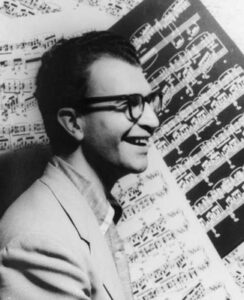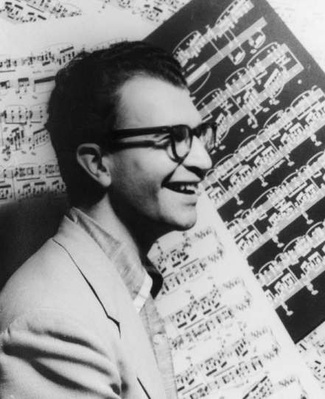
The Beginner’s Guide To Dave Brubeck
by
Ron Drotos
Even though Dave Brubeck is one of the most famous jazz pianists ever, not many listeners have a good overview of his stylistic development and how it took place over the course of his career. My goal is to give you “the overall picture” of this jazz legend so that when you hear one of his recordings, you’ll be able to “place” it within the larger perspective of who he was as a musician. Enjoy! (And good luck with your own piano playing!)
First and foremost, I’d like to begin by saying that Dave Brubeck was a very nice person. I had the privilege of meeting him several times and you can read about one of those special meetings here. I also had fun playing Dave’s own electric piano during an outdoor concert I did with his son Chris. I think the enthusiasm he displayed for younger musicians like myself also came out in his own music. He didn’t “hold back.”
Dave Brubeck was born in 1920, and grew up on his father’s cattle farm. His mother was a classical pianist and both of these circumstances influenced his music greatly. He was also influenced by his college composition teacher, the famous French composer Darius Milhoud, who was teaching at California’s College Of The Pacific. Milhoud encouraged the young Brubeck to experiment with polytonality and other 20th century compositional techniques that Milhoud himself had helped pioneer.
One of Dave’s first professional groups was an Octet which incorporated classical techniques into the jazz idiom. It’s worth noting that the group, which recorded several pieces in 1949, sounds similar in some ways to the more famous “Birth Of The Cool” band that was assembled in New York City by Miles Davis, Gil Evans, and Gerry Mulligan at around the same time. Even though neither group knew of the other, there was definitely something “in the air” at this time in the development of jazz that encouraged experimental small groups like this.
You can really hear the Octet’s classical side come through in this piece, called “Fugue On Bop Themes,” where they use Bach-like counterpoint in a jazz context. This still sounds fresh today!
Brubeck went on to make some solo piano recordings, which were relatively rare in the jazz world of the 1950s. Here he is playing his own composition, “In Your Own Sweet Way,” from 1956. Some of his solo piano arrangements were published around this time, and had a big influence on many aspiring jazz pianists, including a young Keith Jarrett!
https://www.youtube.com/watch?v=cVHKHCMDnfM
The pianistic textures that Brubeck used on “In Your Own Sweet Way,” such as inner voice movement and independent bass lines, sound pretty standard today, but in 1956 they set him apart from most of his contemporaries. (Remember, this was a few years before Bill Evans and later, Herbie Hancock, developed their mature styles.)
Brubeck soon became very famous and was featured on the cover of Time magazine. He was a “household name.” He continued to experiment with advanced techniques such as polytonality and time signatures other than the usual 4/4/ and 3/4. Here’s his biggest hit, “Take Five,” which was composed by Paul Desmond, who played alto sax in Dave’s classic quartet.
When “Take Five” came out in 1959, not many jazz musicians could improvise in 5/4 time. Today, it’s so commonplace that Brubeck and Desmond can truly be said to have been “ahead of their time.” For reference, keep in mind that this was recorded in the same year as the Miles Davis album “Kind of Blue.” Both recordings used modal improvisation to expand the boundaries of jazz beyond the bebop style of the 1940s and early-to-mid 1950s.
Here’s another of their classics, “Blue Rondo a la Turk,” which was inspired by the rhythms of Turkish street musicians:
Brubeck and his Quartet continued to be among the most successful jazz musicians. Indeed, he was one of the few post-Swing Era jazzers to achieve a high degree of fame with the general public. Even as many of his jazz colleagues such as Miles Davis began playing rock and pop styles in the 1970s, Brubeck continued playing large concerts of exclusively jazz music. I think a big part of this had to do with his approach to rhythm, which, despite his experimental harmonic and meter-based techniques, remained rooted in pre-bebop rhythmic concepts. In other words, Brubeck wasn’t afraid to play riffs and boogie-based rhythms that other modern jazz musicians might consider to be “old-fashioned.” The listening public loved this and continued to make him a commercial success.
He also avoided pre-conceived “licks” and patterns when he soloed, preferring instead to start fresh every time. This aspect of his playing also kept his music from sounding predictable or stale.
Several of Brubeck’s sons grew up to become professional musicians like their father. Dave actually formed a group with his sons and called it Two Generations Of Brubeck. Here’s their recording of his classic tune “Unsquare Dance,” from 1973:
https://www.youtube.com/watch?v=Tjn5UG491K0
I remember learning this tune for a concert I played with Dave’s son, Chris, who plays bass and trombone. To become comfortable with the 5/4 time signature, I spent two full weeks counting to 5, over and over, as I took a long daily walk. The effort paid off, and I felt comfortable improvising on the tune when we played it in the concert. (I even adapted a Herbie Hancock diminished “lick” to play in 5/4 time during one of my solo breaks!)
Here’s an old joke:
Question: How do you sing the song “I Got Rhythm” in 5/4 time”
Answer: “I got some rhythm!” (adding the word “some” to the lyric adds an extra beat)
OK – let’s get back to the music …
As Brubeck grew older, his interest in composing sacred music grew as well. He wrote many choral pieces based on religious texts and sometimes performed with his quartet and chorus together. Here’s a piece from this part of his output, “To Hope!”
It’s amazing how many musical elements Brubeck has incorporated in “To Hope!” He effortlessly goes from tender “classical” playing, to a jazzy section that sounds like an old-time spiritual, to a lively choral section that brings in Latin percussion. I’ve had the pleasure of conducting his choral pieces in his hometown in Connecticut, and I’ll attest that his sacred writing is very heartfelt and genuine.
Despite his public success and influence on generations of jazz musicians, Brubeck was sometimes criticized for “not swinging” or playing stiffly. Ironically, and to his credit, the avant garde and “ultra hip” pianist Cecil Taylor provided what is perhaps the best defense of Brubeck in this regard. Cecil basically said that Brubeck grew up riding horses on a farm in California. Of course he played with a different rhythmic feel than that of an East Coast urbanite jazz pianist. Both Cecil, and of course Brubeck himself, understood the value of individuality in a way that many of their fellow jazz musicians didn’t.
Even though I’ve always been a big Brubeck fan and he had a huge influence on me as a developing player, I was shocked to hear his solo on “I Hear A Rhapsody,” from his 1982 album, Paper Moon on the radio one day. His piano solo on this proves that he could play bebop with the best of them when he chose to do so!
https://www.youtube.com/watch?v=qLRGTyloHwg
As I mentioned above, a big part of Brubeck’s popularity with the general public came from his willingness to play old-time blues riffs and rhythms in his unique, energetic way. Let’s conclude our overview of Brubeck’s career with a recording he did on August 2, 1988, in Cincinnati, Ohio. I was at the recording session and can attest to how much Dave astonished everyone present with his amazing rendition of the old classic “When The Saints Go Marching In.”
The Cincinnati Pops Orchestra played a big concert where they had invited a whole slew of top jazz musicians to perform with them. I was there as assistant to the baritone sax player Gerry Mulligan and was thrilled to meet such stars as Cab Calloway, Doc Severinsen, and to speak wth Dave Brubeck again. The musicians played an outdoor concert and then went to the concert hall the next day to record all the musical arrangements from the concert. For “The Saints,” the arranger had written the beginning and ending, but left a gig gap in the middle for Brubeck to “come up with something.” Nobody knew what he had in mind until he showed up at the rehearsal in Cincinnati.
I watched the other musicians and concert producers literally gasp in delight as Dave played what he had “come up with.” He started simply, playing “The Saints” as a quiet spiritual, but reharmonized in a stunningly beautiful way. I remember thinking, “Now that’s how I want to play piano someday!” Then, his left hand began a gentle boogie bass line while his right hand superimposed bitonal chords for an otherworldly effect. Finally, he led bassist Ray Brown and drummer Ed Shaughnessy in a rousing, major key finale before coming to a calm “landing,” to usher in the next soloist.
Dave Brubeck’s performance of “When The Saints Go Marching In” isn’t one of his more popular recordings, but for me, it shows the true scope of his playing and how it relates to the entire history of jazz. And looking back at it now, it seems to me that he was also inspired by the song’s beginnings as a religious hymn. This video is from the live concert. Dave’s piano feature starts at 5:58. Enjoy!
For someone as prolific as Dave Brubeck, this Beginner’s Guide is a just a brief overview of his work, touching upon a few high points and stylistic landmarks. But I do hope that this enables you to put his music in context and understand it a little better.
Enjoy the journey, and “let the music flow!”
Ron
To learn more:
Dave Brubeck: Wikipedia
NPR interview with Dave Brubeck
Learn the 5 Essential Left Hand Techniques with my free ebook: Left Hand Techniques for Jazz Piano
You’ll also get my weekly jazz newsletter with practice tips and inspiration

